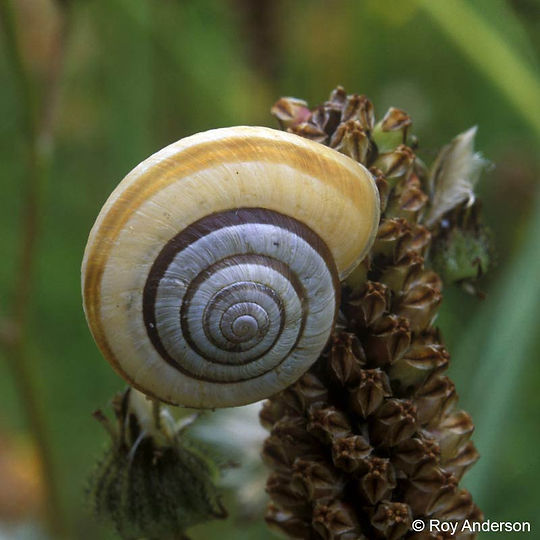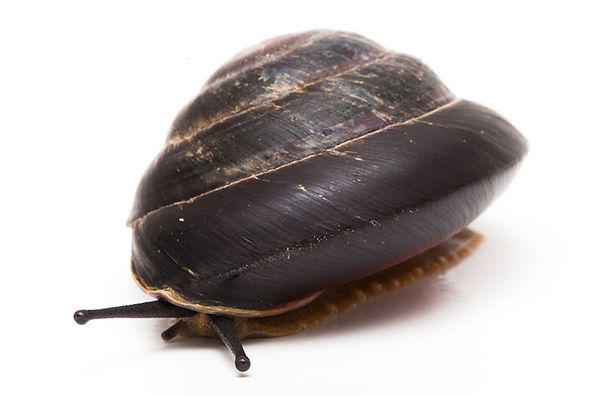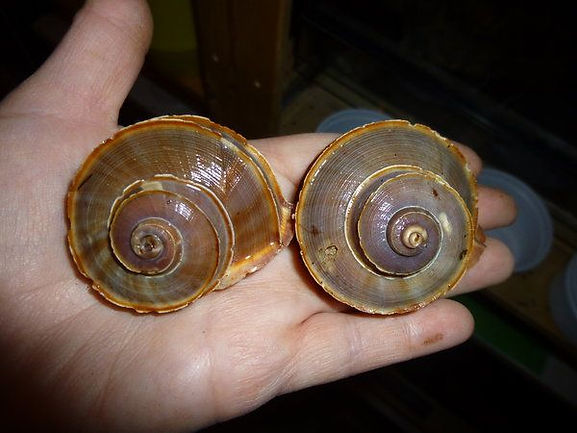This species of snail makes and uses love darts during mating.
- Helicella itala :
Life cycle :
The size of the egg is 1.5 mm.[1]







Helicella itala is a species of medium-sized, air-breathing land snail, a terrestrial pulmonate gastropodmollusk in the family Hygromiidae, the hairy snails and their allies.
Scientific classification
Kingdom : Animalia
Phylum : Mollusca
Class:Gastropoda
(unranked) : clade Heterobranchia
clade Euthyneura
clade Panpulmonata
clade Eupulmonata
cladeStylommatophora
informal groupSigmurethra
Superfamily : Helicoidea
Family : Hygromiidae
Genus : Helicella
Species : H. itala
Binomial name :
Helicella itala
(Linnaeus, 1758)
Two views of a shell of Helicella itala
Drawing of love dart of Helicella itala.
Description :
The 12-20 mm. shell is broad and very depressed with an open coil forming a convex, low spire. The umbilicus is very wide. The whorls are slightly convex and have shallow sutures. The aperture is elliptical and lacks an internal rib. The surface (periostracum) is white or pale yellow-brown and dark brown or yellow-brown spiral bands and fine irregular growth ridges.

Caracolus sagemon ssp. Cuba type 4 striped :
Adult size: 35mm
Caracolus sagemon ssp. Cuba typ 4 is smaller than Pleurodonte marginella but the hight of the shell is bigger and more arched. Colour of the foot is with yellow or orange tint. Coloration of the shell of the form striped is similar to Pleurodonte marginella semiaperta, but coloration is much darker. This species is very attractive and not hard to keep.
Helicella Itala
Family
Helicidae
Species
Helicella itala (Linnaeus, 1758)
Common Name
Heath snail
Description
This species has white, tan or pale yellow shells that are approximately 5-12 mm high and 9-25 mm wide, with 5.5-6.5 whorls. There may also be dark brown stripes on the conical shell of this group. The shellhas a wide umbilicus.
Native Range
Western Europe
Distribution
Europe: Great Britain, Ireland, Germany, France, Belgium, Netherlands, Denmark, Austria, Poland
Australia
Ecology
This species occupies open habitats, including grasslands. It can also be found in disturbed habitats (e.g. roadsides, railways and forested dunes). The heath snail aestivates on vertical objects (e.g., blades of grass). This species is generally considered a contaminant; however, in agricultural setting this species may achieve pest status when there is a high population density. Large numbers of heath snails can clog machinery and add moisture to harvested crops. This added moisture often leads to spoilage and in some cases infestation by secondary pathogens. Some secondary pathogens are capable of producing toxins which may be harmful to humans and cattle. They produce a maximum of 90 eggs per clutch and can live up to 3 years, reproducing twice per year.
Synonyms
Helicella ericetorum O.F. Muller
References
Anderson 2005; Kerney et al. 1979
- Helix species ( GARDEN SNAIL ) :
Garden Snail – Helix aspersa :
Description :
The garden snail (helix aspersa) is one of the best-known species of snails in the world. As all terrestrial snails is a gastropod mollusk. It is so common, that it is one of the most proliferated terrestrial mollusks.
The helix aspersa is also known with the common name of “European Brown Garden Snail”, but its scientific name is has alternative versions. Some scientist name this snail as Cornu aspersum, Cantareus aspersus or Cryptomphalus aspersus.
This species is native of Europe but it has been introduced in several parts of the world where it has become a pest for crops and gardens.



Anatomy :
The Helix aspersa is an air-breathing snail, which has a single lung. They have a brownish soft body, which is usually covered with slimy mucus.
They have yellow or cream-colored shells with brown spiral stripes. When a snail is old enough, a lip is formed at the edge of the shell aperture. The shell of this species has a height of about 1-1.4 inches and a width of 1-1.5 inches.
The garden snail has a flat muscular organ called a foot that helps it move with a gliding motion helped by the release of a mucus to reduce friction with the rough surface.
This mucus is the reason why snails leave a wet trace of slime when they move around.
Garden Snail or Helix aspersa
Behavior :
Garden snails are mainly active during nights or early mornings when the sun is not shinning, however they can be active during cloudy or rainy days.
Some Helix aspersa hibernate during winter months, especially when they are mature, but they return to activity with the spring.
They are extremely slow as their fastest speed is only 1.3 centimeters per second.
Habitat and Distribution :
The Helix aspersa was originally found in the British islands, western Europe and the Mediterraneo, reaching some regions of north Africa, and the middle east.
However, this snail has been introduced to several places where they have become agricultural pests. These places include the United States, Canada, South Africa, Australia, New Zealand, Mexico, Chile, Argentina and some others. This snail has arrived to these places either by accidentally hidden in plant or vegetable shipments or intentionally imported for some purpose.
Diet and Feeding Habits
Garden snails are herbivorous and feed on several kinds of fruit trees, garden plants, crop vegetables and some cereals.
Snail mouth is beneath its tentacles and it has a toothed ribbon called the radula, which is used to fragment its food. This structure is exclusive of mollusks and most of them have one.
Close up to garden snail on green background
Reproduction :
Like other gastropod mollusks, the Helix aspersa is hermaphrodite; this means that it has both male and female organs. However, mating is required for fertilization, even tough self-fertilization is possible for this species.
The mating process is complex and interesting. After some pairing and courtship, this species start the mating process that can last from four to twelve hours and usually includes the exchange of a love dart, a kind of calcareous arrow with a purpose still unclear.
During the mating process they fertilize each other and they both will lay around 80 eggs 3 to 6 days after the mating occurs. To deliver his eggs, each snail will create a nest digging a hole in the soil with its foot. The nest will be 1 to 1.5 inches deep where the eggs will be delivered.
Gardens snails are able to deliver up to six batches of eggs in a single year. Each newborn, will take one to two years to mature.
Predators :
Garden snails are food source for some animals like lizards, frogs and worms. Predatory insects and other species of snails will also eat garden snails.
Some birds, especially ducks will feed on these snails.
Relation with humans :
This species is edible and it is sometimes used for cooking, although it should not be confused with the helix pomatia, the “Escargot”.
Although is considered a pest in most places, it has acquired popularity in the cosmetic industry because the regenerative properties of their mucus.
Other websites :
- www.en.wikipedia.org/wiki/Helix_(gastropod)
- www.snail-world.com/garden-snail-infographic/
- www.petsnails.co.uk/species/helix-aspersa.html#start
- www.aqualandpetsplus.com/Bug,%20Snails,%20Land
- www.arkive.org/garden-snail/helix-aspersa/
- www.entnemdept.ufl.edu/creatures/misc/gastro/brown_garden_snail.
- www.ipm.ucanr.edu/PMG/r107500111.
Garden Snail (Helix Aspersa)
The Burgundy Snail - Helix pomatia - Land Snails
- caracolus sagemon :





Caracolus sagemon ssp. Cuba type 4 dark :



caracolus sagemon
- Cerion uva :




Cerion is a genus of small to medium-sized tropical air-breathing land snails, terrestrial pulmonategastropods in the family Cerionidae, sometimes known as the peanut snails. The genus is endemic to the Caribbean region.
The name Cerion is based on the Greek word kerion, signifying honeycomb, and is given to these shells because the form of the shell resembles that of a beehive; hence they were at one time known asbeehive shells.[3]
The fossil range of Cerion is possibly from the Upper Cretaceous of Montana, or the early Miocene ofFlorida.[1] Records of Cerion in Pleistocene are rare.[1]
Species :
Species within the genus Cerion include:
Scientific classification :
Kingdom:Animalia
Phylum:Mollusca
Class:Gastropoda
(unranked):clade Heterobranchia
clade Euthyneura
clade Panpulmonata
clade Eupulmonata
cladeStylommatophora
informal groupSigmurethra
Superfamily:Urocoptoidea
Family:Cerionidae
Genus:Cerion
Röding, 1798[2]
Cerion
Temporal range: Early Miocene–Recent
Drawing of a live individual of Cerion chrysalis

Five live but estivating Cerion snails on limestone wall of Windley Key Fossil Quarry (with two other non-Cerion snails), Florida

-
Cerion acuticostatum Sánchez Roig, 1948[4]
-
Cerion aguayoi Torre & Clench, 1932[4]
-
Cerion alberti Clench & Aguayo, 1949[4]
-
Cerion alleni Torre, 1929[4]
-
Cerion anodonta[citation needed]
-
Cerion arangoi (Pilsbry & Vanatta, 1896)[4]
-
Cerion banesense Clench & Aguayo, 1949[4]
-
Cerion barroi Aguayo & Jaume, 1957[4]
-
Cerion basistriatum Pilsbry & Vanatta, 1895[4]
-
Cerion bioscai Aguayo & Jaume, 1951[4]
-
Cerion blanesi Clench & Aguayo, 1951[4]
-
Cerion cabocruzense Pilsbry & Torre, 1943[4]
-
Cerion capraia[citation needed]
-
Cerion caroli Aguayo & Torre, 1951[4]
-
Cerion casablancae[citation needed]
-
Cerion catherwoodianum Wurtz, 1950[4]
-
Cerion ceiba Clench, 1948[4]
-
Cerion chaparra Aguayo & Sánchez Roig, 1953[4]
-
Cerion chaplini Wurtz, 1950[4]
-
Cerion chrysalis[citation needed]
-
Cerion chrysaloides[citation needed]
-
Cerion circumscriptum Aguayo & Jaume, 1951[4]
-
Cerion cisneroi Clench & Aguayo, 1951[4]
-
Cerion cobarrubia Aguayo & Jaume, 1951[4]
-
Cerion columbiana[citation needed]
-
Cerion columbinus Sánchez Roig, 1951[4]
-
Cerion coutini Sánchez Roig, 1951[4]
-
Cerion crassilabris[citation needed]
-
Cerion crassiusculum Torre in Pilsbry & Vanatta, 1899[4]
-
Cerion cyclostomum (Küster, 1841)[4]
-
Cerion dimidiatum (Pfeiffer, 1847)[4]
-
Cerion disforme Clench & Aguayo, 1946[4]
-
Cerion dorotheae Aguayo & Jaume, 1951[4]
-
Cerion ebriolum Aguayo & Jaume, 1951[4]
-
Cerion evolva[citation needed]
-
Cerion fasciata[citation needed]
-
Cerion feltoni Sánchez Roig, 1951[4]
-
Cerion floridanum[citation needed]
-
Cerion geophilum Clench & Aguayo, 1949[4]
-
Cerion grilloensis Sánchez Roig, 1951[4]
-
Cerion grisea[citation needed]
-
Cerion gundlachi (Pfeiffer, 1852)[4]
-
Cerion herrerai Aguayo & Jaume, 1951[4]
-
Cerion hessei Clench & Aguayo, 1949[4]
-
Cerion humberti Clench & Aguayo, 1949[4]
-
Cerion hyperlissum Pilsbry & Vanatta, 1896[4]
-
Cerion incanum[citation needed]
-
Cerion incrassatum (Sowerby, 1876)[4]
-
Cerion infandulum Aguayo & Torre, 1951[4]
-
Cerion infandum (Shuttleworth in Poey, 1858)[4]
-
Cerion iostomum (Pfeiffer, 1854)[4]
-
Cerion johnsoni Pilsbry & Vanatta, 1895[4]
-
Cerion josephi Clench & Aguayo, 1949[4]
-
Cerion kusteri (Pfeiffer, 1854)[4]
-
Cerion laureani Clench & Aguayo, 1951[4]
-
Cerion longidens Pilsbry, 1902[4]
-
Cerion macrodon Aguayo & Jaume, 1951[4]
-
Cerion magister Pilsbry & Vanatta, 1896[4]
-
Cerion manatiense Aguayo & Jaume, 1951[4]
-
Cerion marielinum Torre in Pilsbry, 1927[4]
-
Cerion maritimum (Pfeiffer, 1839)[4]
-
Cerion microdon Pilsbry & Vanatta, 1896[4]
-
Cerion microstonum (Pfeiffer, 1854)[4]
-
Cerion miramarae Sánchez Roig, 1951[4]
-
Cerion multicostum (Küster, 1845)[4]
-
Cerion mumia (Bruguière, 1792)[4]
-
Cerion mumiola (Pfeiffer, 1839)[4]
-
Cerion nanus(Maynard, 1889)[5]
-
Cerion nipense Aguayo, 1953[4]
-
Cerion obesum[citation needed]
-
Cerion orientale Clench & Aguayo, 1951[4]
-
Cerion palmeri Sánchez Roig, 1948[4]
-
Cerion pandionis Aguayo & Jaume, 1951[4]
-
Cerion paredonis Pilsbry, 1902[4]
-
Cerion pastelilloensis Sánchez Roig, 1951[4]
-
Cerion paucicostatum Torre, 1929[4]
-
Cerion paucisculptum Clench & Aguayo, 1952[4]
-
Cerion peracutum Clench & Aguayo, 1951[4]
-
Cerion persuasa[citation needed]
-
Cerion pilsbryi[citation needed]
-
Cerion pinerium Dall, 1895[4]
-
Cerion politum (Maynard, 1896)[4]
-
Cerion prestoni Sánchez Roig, 1951[4]
-
Cerion pretiosus Sánchez Roig, 1951[4]
-
Cerion pseudocyclostomum Aguayo & Sánchez Roig, 1953[4]
-
Cerion pupilla[citation needed]
-
Cerion ramsdeni Torre in Welch, 1934[4]
-
Cerion regina[citation needed]
-
Cerion regula[citation needed]
-
Cerion restricta[citation needed]
-
Cerion ricardi Clench & Aguayo, 1951[4]
-
Cerion saccharimeta[citation needed]
-
Cerion saetiae Sánchez Roig, 1948[4]
-
Cerion sagraianum (Pfeiffer, 1847)[4]
-
Cerion sainthilarius Sánchez Roig, 1951[4]
-
Cerion sallei[citation needed]
-
Cerion salvatori Torre in Pilsbry, 1927[4]
-
Cerion sanctacruzense Aguayo & Jaume, 1951[4]
-
Cerion sanctamariae Aguayo & Jaume, 1951[4]
-
Cerion sanzi Blanes in Pilsbry & Vanatta, 1898[4]
-
Cerion scalarinum (Gundlach in Pfeiffer, 1860)[4]
-
Cerion scopulorum Aguayo & Jaume, 1951[4]
-
Cerion sculptum (Poey, 1858)[4]
-
Cerion sisal Clench & Aguayo, 1952[4]
-
Cerion striatellum[citation needed]
-
Cerion stupida[citation needed]
-
Cerion tanamensis Sánchez Roig, 1951[4]
-
Cerion tenuilabre (Gundlach in Pfeiffer, 1870)[4]
-
Cerion torrei Blanes in Pilsbry & Vanatta, 1898[4]
-
Cerion tridentatun Pilsbry & Vanatta, 1895[4]
-
Cerion uva[citation needed]
-
Cerion vaccinum[citation needed]
-
Cerion vanattai Clench & Aguayo, 1951[4]
-
Cerion venustum (Poey, 1858)[4]
-
Cerion victor Torre, 1929[4]
-
Cerion vulneratum (Küster, 1855)[4]
-
Cerion yumaensis[citation needed]




- Chocolate Banded Snail (Eobania vermiculata). :
When the Danish malacologist Otto Friedrich Müller first described this species in 1774 after having returned from a journey to Italy (which gave him the right to name the species), he called it "Nudel-Snekken" (noodle snail), because the shell pattern of dissolved stripes reminded him of Italian Vermicelli noodles. Obviously he had not exclusively been occupied with snails during his voyage. Until today the snail is calledEobania vermiculata (O.F. Müller 1774) - only Müller's name is set into brackets; he had described it as Helix vermiculata in 1774.
Description: Compared to other Helicid snails, Eobania vermiculata has got a rather flattened than globular shell, the whorls ascending only little with flat sutures in between. The last whorl descends rapidly towards the aperture (see picture on the left). The apertural lip is evolved noticeably, it completely covers the shell navel (umbilicus). As an adaptation to the snail's usually warm and dry environment, the shell has got a thick wall and a white ground colour. On this there are up to 5 dark brown bands (hence the name chocolate banded snail). The shell bands are often dissolved into separate narrow stripes, overlaid by a whitish net pattern (which led to Müller's choice of name).
Dimensions: W: 14 - 27 mm; H: 22 - 30 mm; N: 5 - 6. (Abbreviations).
Habitat and Distribution: Eobania vermiculata lives on dry vegetation on fields and in hedges, often also inhabits agricultural areas, such as gardens and vineyards.
The species is distributed in all of the Mediterranean. In Southern France Eobania vermiculata also extends its area of distribution into the inner country, such as the upper Rhône valley and the upper valley of the Garonne river. In other places in Europe, such as in Bad Schwartau in Northern Germany, in Cologne, and in Györ in Hungary, the species has been introduced. With food transports, it also reached America and Australia. In the United States, Eobania vermiculata has been introduced in Louisiana and Texas, but does not pose a severe threat to agriculture. In Japan, the first naturalized population has been described from Urayasu in the Chiba prefecture. In the meantime another population has been reported from that region.
Economic Importance:
In a large part of its distribution area, the chocolate banded snail is collected as food. This doubtlessly has led to a large extent to the species current distribution throughout the Mediterranean and beyond. On Crete, Eobania vermiculata and other terrestrial snails are commonly sold alive on markets. In France as well, the snail is commonly referred to as "Morguette" and picked to be prepared as food. In Spain, Eobania vermiculata is called "Caracol de huerta" (vegetable garden snail), for obvious reasons.


Chocolate banded snail (Eobania vermiculata), Rab Island
(Croatia). Picture: Andreas Gruber.
Chocolate banded snail (Eobania vermiculata), Rab Island
(Croatia). Picture: Andreas Gruber.
Further Information:
-
Čejka, T.; Horsàk, M.; Juřičkovà, L. (2010): A Mediterranean snail Eobania vermiculata (O.F. Müller 1774) in NW Germany (Link).
-
Aydin Örstan: How to tell Eobania vermiculata from Helix aspersa.
-
Francisco Welter-Schultes: Eobania vermiculata species homepage.




Eobania vermiculata - Cyprus
- helicophanta bicingulata :
Another wonderful species of the genus Helicophanta. Slightly smaller than H. magnifica and significantly different in the shape of seashells and its greater robustness.
Family : ACAVIDAE
Species :Helicophanta bicingulata
Author : (Smith, 1882)
Locality : Madagascar. SE Madagascar. N of Fort-Dauphin. East of Evatra village. In Rainforest. Circa 2000.
Size : 66.2 mm (2.61 inch)
Common Family : Lustful Snails
Common Name : Two-banded Helicophanta





Helicophanta
From Wikipedia, the free encyclopedia
Helicophanta is a genus of air-breathing land snails, a terrestrial pulmonate gastropods mollusks in the family Acavidae.
Species :
Species within the genus Helicophanta include:
-
Helicophanta amphibulima
-
Helicophanta betsiloensis
-
Helicophanta bicingulata
-
Helicophanta falconeri
-
Helicophanta farafanga
-
Helicophanta geayi
-
Helicophanta gloriosa
-
Helicophanta goudotiana
-
Helicophanta guesteriana
-
Helicophanta ibaraoensis
-
Helicophanta magnifica
-
Helicophanta oviformis
-
Helicophanta petiti
-
Helicophanta socii
-
Helicophanta souverbiana
-
Helicophanta vesicalis
Helicophanta :
Helicophanta gloriosa


Scientific classification :
Kingdom:Animalia
Phylum:Mollusca
Class:Gastropoda
(unranked):clade Heterobranchia
clade Euthyneura
clade Panpulmonata
clade Eupulmonata
cladeStylommatophora
informal groupSigmurethra
Superfamily:Acavoidea
Family:Acavidae
Genus:Helicophanta
Férussac, 1821[1]
- Tropidophora cuveriana :
Just reminder for this website for other Land snails ..
POMATIASIDAE - Tropidophora cuveriana (Petit, 1841)
Tropidophora cuveriana is a species of mollucs in the family Pomatiidae.





Tropidophora cuveriana :

Tropidophora cuveriana at Madagascar
Scientific classification :
Kingdom:Animalia
Phylum:Mollusca
Class:Gastropoda
Subclass:Orthogastropoda
Superorder:Caenogastropoda
Order:Sorbeoconcha
Suborder:Hypsogastropoda
Infraorder:Littorinimorpha
Superfamily:Littorinoidea
Family:Pomatiidae
Genus:Tropidophora
Binomial name
Tropidophora cuveriana
Petit de la Saussaye, 1852
Tropidophora Cuveriana on hand
Tropidophora Cuveriana
LAND SNAILS ... Introduction
LAND SNAILS ... Care
LAND SNAILS .... Species 1 .... 2 ... 3 .... 4 .... 5
LAND SNAILS ... Introduction
LAND SNAILS ... Care
LAND SNAILS .... Species 1 .... 2 ... 3 .... 4 .... 5
Due to the large quantity of land snails species and the new yearly discoveries we will shortlisted the famous and most colorful and strange shape of these creatures . yet this hobby is challenging for the most of hobbyists ..
All Picture here and below is courtesy to :
All Picture here and below is courtesy to :